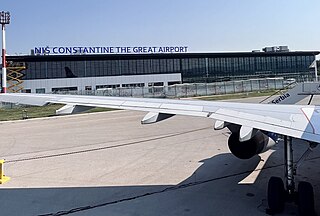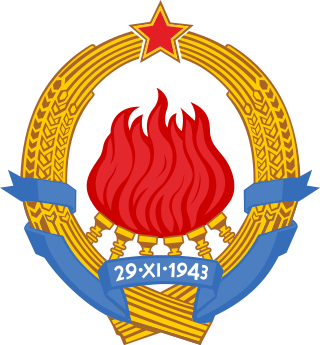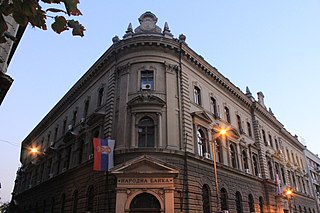The following is a summary of the transport system of the Republic of North Macedonia.
Transport in Serbia includes transport by road, rail, air and water. Road transport incorporates a comprehensive network of major and minor roads. Rail transport is fairly developed, although dual track and electrification are not very common. Water transport revolves around river transport while air transport around country's three main international airports.
Adria Airways d.o.o. was the flag carrier of Slovenia, operating scheduled and charter services to European destinations. The company's head office was at Ljubljana Jože Pučnik Airport in Zgornji Brnik, Cerklje na Gorenjskem, near Ljubljana. On 30 September 2019, the airline declared bankruptcy and ceased all operations.
Air Yugoslavia was an airline based in Belgrade, Yugoslavia. It was established in 1969 and operated numerous international charter passenger services, using aircraft from parent airline JAT Yugoslav Airlines. Its main base was Belgrade Nikola Tesla Airport.
The 1980–81 Yugoslav First League season was the 35th season of the First Federal League, the top level association football competition of SFR Yugoslavia, since its establishment in 1946. A total of 18 teams competed in the league, with the previous season's champions Red Star successfully defending their title, finishing the season two points clear of runners-up Hajduk Split.
The 1981–82 Yugoslav First League season was the 36th season of the First Federal League, the top level association football competition of SFR Yugoslavia, since its establishment in 1946. The season began on 26 July 1981 and ended on 2 May 1982. Dinamo Zagreb led by Miroslav Blažević won their fourth title five points ahead of previous season's champions Red Star.

Niš Constantine the Great Airport, located 4 km (2.5 mi) northwest of downtown Niš, in the suburbs of Medoševac and Popovac. It is the second-largest and second-busiest airport in Serbia, after Belgrade Nikola Tesla Airport. Niš Military Air Base, the Serbian-Russian Emergency Response Centre and Centre for Aerial Firefighting Duties are all located on the site of the airport.

Skopje International Airport, also known as Skopje Airport and Petrovec Airport is the larger and busier of the two international airports in North Macedonia, with the other being the St. Paul the Apostle Airport in Ohrid, which is located 170 km (110 mi) southwest from the national capital Skopje. The airport was previously named Skopje Alexander the Great Airport.
The First League of Yugoslavia's 1991/1992 season was the 64th edition of the Yugoslav First League, the premier football club competition of SFR Yugoslavia. It was the last edition in which professional football teams from SR Bosnia and Herzegovina and SR Macedonia participated, as well as the last of the SFR Yugoslavia in general as the First League of FR Yugoslavia was established the following season. Red Star Belgrade won the competition.
Aeroput was an airline and flag carrier of Yugoslavia from 1927 until 1948.

Yugoslavia had various administrative divisions throughout its 74 years of existence.
The subdivisions of the Kingdom of Yugoslavia existed successively in three different forms. From 1918 to 1922, the Kingdom of Yugoslavia maintained the pre-World War I subdivisions of Yugoslavia's predecessor states. In 1922, the state was divided into 33 oblasts or provinces and, in 1929, a new system of nine banates was implemented.

Football in Yugoslavia had different levels of historical development depending on the geographical regions. Following the extreme popularity of the sport in Central Europe, it soon became the most popular sport in the territories of Yugoslavia as well.
The 1965–66 Yugoslav Second League season was the 20th season of the Second Federal League, the second level association football competition of SFR Yugoslavia, since its establishment in 1946. The league was contested in two regional groups, with 18 clubs each, two more than in the previous season.
This is a list of historical administrative divisions of Serbia since the establishment of the Principality of Serbia until today.

Telephone numbers in Yugoslavia consisted of a 3-digit area code followed by 6 digits. In Serbia, they mainly began with 1, 2 or 3, in Croatia 4 or 5, in Slovenia 6, Bosnia and Herzegovina 7, in Montenegro 8 and in North Macedonia 9.

The National Bank of Yugoslavia was the central bank of Yugoslavia, succeeding the National Bank of the Kingdom of Serbia in Belgrade in 1920. It was formally known as the National Bank of the Kingdom of Serbs, Croats and Slovenes until 3 October 1929, and as the National Bank of the Kingdom of Yugoslavia from then until the invasion of Yugoslavia in April 1941.






